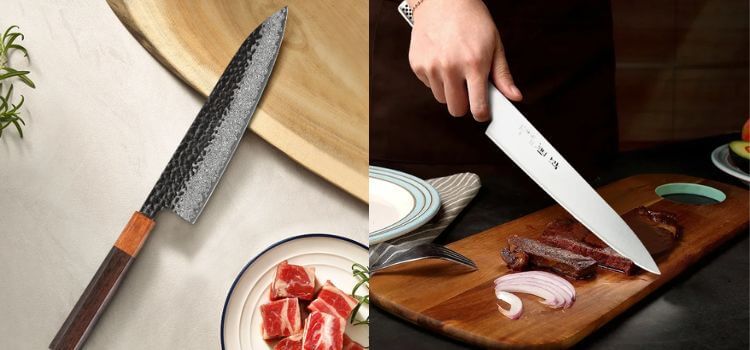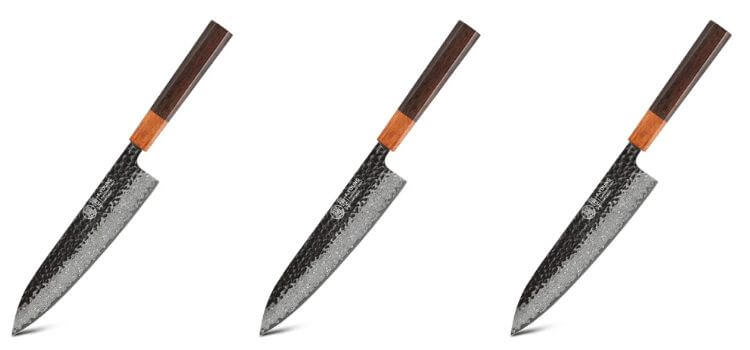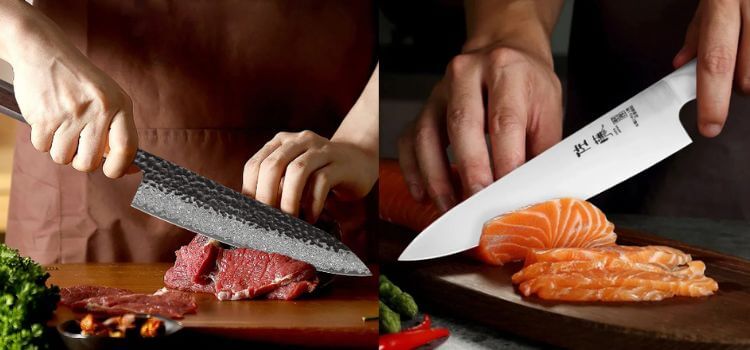As an Amazon Associate, I earn from qualifying purchases

In culinary craftsmanship, the debate between Gyuto and Chef Knives has long stirred the pot among chefs and cooking enthusiasts. These two versatile blades share similarities yet have distinct characteristics catering to different kitchen tasks.
Embark on an exploration with us as we examine the nuances of Gyuto versus Chef Knife, revealing their distinct characteristics, functions, and the perfect situations to utilize each blade. Let’s slice through the cutlery confusion and sharpen our understanding of these essential kitchen tools.
Origins and Design
Gyuto Knife

Origin and history:
The Gyuto Knife, revered as a Japanese Chef’s Knife, carries with it a rich legacy rooted in Japan’s Samurai era. It was originally designed as a multi-purpose blade for the Samurai warriors on and off the battlefield, making it an all-rounder in functionality.
Blade design and characteristics:
The Gyuto Knife features an elongated, slim blade that culminates in a finely pointed tip. Commonly crafted from high-carbon stainless steel, it boasts a straight edge that gently curves towards the tip. The blade’s spine is thicker, tapering to an ultra-thin cutting edge, This makes it perfect for precise cutting and slicing tasks.
Handle styles and ergonomics:
Traditionally, Gyuto Knives have a Japanese-style wooden handle called Wa (meaning harmony). This type of handle is lightweight and has a round or octagonal shape for better grip and control. However, modern versions may also feature Western-style handles for improved ergonomics and comfort.
Chef Knife

Origin and history:
While the origins of the Chef Knife are debated, it is believed to have originated in France during the 19th century. It was designed by a French cutlery company as an all-purpose kitchen knife for chefs, thus earning its name.
Blade design and characteristics:
The Chef Knife has a slightly curved blade with a pointed tip, similar to the Gyuto. Nevertheless, it presents a shorter and broader profile compared to the Gyuto, featuring a thicker spine and a more pronounced curve near the tip. This design makes it ideal for rocking motions while cutting and chopping.
Handle styles and ergonomics:
Chef knives usually feature handles in a Western style, designed using materials like wood, plastic, or metal, these creations enhance both functionality and aesthetic appeal. The handles are usually larger and heavier than WA handles, providing a better grip and balance for heavy-duty tasks.
Functionality and Versatility
Gyuto Knife
The Gyuto Knife’s design makes it a versatile kitchen tool. Its long, narrow blade allows for precise and even slicing vegetables, fruits, and meats. The finely honed, pointed tip is superbly suited for intricate tasks like peeling and carving, making it an exceptional option for both professional chefs and culinary aficionados at home.
Primary uses in the kitchen
- Slicing and dicing vegetables, fruits, and meats
- Peeling and carving tasks
- Chopping herbs and nuts
Ideal scenarios for use
- Preparing multi-course meals with different types of ingredients
- Creating visually appealing dishes that require precision cutting
Pros and Cons of Gyuto Knife
Pros:
- Versatile and multi-functional
- Precise and accurate cutting ability
- Perfect for both professional chefs and culinary aficionados at home
Cons:
- It may require more skill and practice to handle it efficiently
- It’s not suitable for heavy-duty tasks, such as processing large cuts of meat or bones.
Chef Knife
The Chef Knife’s design optimizes it for managing more demanding tasks in the kitchen, blending functionality with precision. Its wider blade and curved edge allow for rocking motions while cutting, making it perfect for chopping, mincing, and dicing.
Primary uses in the kitchen
- Chopping, mincing, and dicing vegetables, fruits, and meats
- Breaking down larger cuts of meat or bones
- Slicing through tough ingredients like squash or root vegetables
Ideal scenarios for use
- Preparing large meals with heavy-duty cutting tasks
- Handling tougher ingredients that require more force to cut
Pros and Cons of Chef Knife
Pros:
- Strong and durable, suitable for heavy-duty tasks
- Ideal for handling tough or thick-skinned ingredients
- Good for beginners due to its simple design and ease of use
Cons:
- It may not be as precise for intricate tasks like peeling or carving
- It is not as versatile as the Gyuto Knife for different cutting techniques.
Choosing the Right Knife: Gyuto vs Chef Knife

When deciding on the right knife for your kitchen, consider factors like your cooking style, the types of ingredients you work with, and your skill level. Gyuto and Chef Knives each possess unique strengths and limitations, rendering them appropriate for varied culinary scenarios.
- If you prioritize precision cutting and are comfortable handling a more delicate blade, then the Gyuto Knife might be the right choice.
- On the other hand, if your cooking involves heavy-duty tasks and handling tougher ingredients, then the Chef Knife may be a better fit.
- If you are a beginner or prefer a simpler design, the Chef Knife may be easier to handle and more versatile for various kitchen tasks.
Maintenance and Care
To guarantee their durability and superior performance in the kitchen, both Gyuto and Chef Knives necessitate meticulous maintenance and care. Consider the following advice to enhance your approach:
- Always hand wash and dry your knife after use. Refrain from placing it in the dishwasher, as doing so can harm the blade.
- Consistently maintain your knife’s edge by sharpening it with a whetstone or honing rod to ensure optimal sharpness.
- Keep your knife in a block or sheath to safeguard the blade and avoid accidents.
Recommendations based on cooking preferences and skill levels
For precision cutting and skilled users:
- Gyuto Knife
For heavy-duty tasks and beginners:
- Chef Knife
For a versatile, all-purpose knife:
- Both Gyuto and Chef Knives can be suitable depending on personal preferences. Consider trying both to see which one works best for you.
Conclusion
In conclusion, Gyuto and Chef Knives are essential tools in any kitchen. Their distinctive designs and features accommodate various scenarios, Customized to match your culinary style and tastes.
By understanding their origins, blade designs, handle styles, functionality, and maintenance needs, you can choose the right knife that suits your needs and skill level. Whichever knife you decide to use, remember to handle it with care and keep it sharp for optimal performance. Happy cooking!
As an Amazon Associate, I earn from qualifying purchases
Pingback: Boning vs Fillet Knife